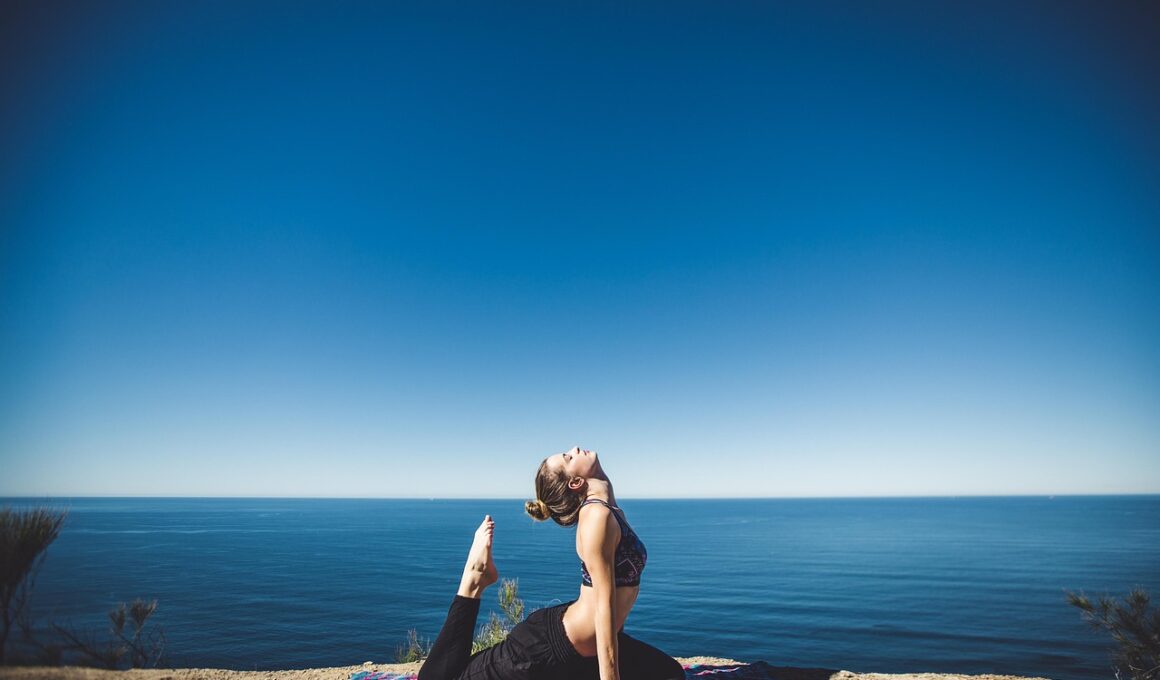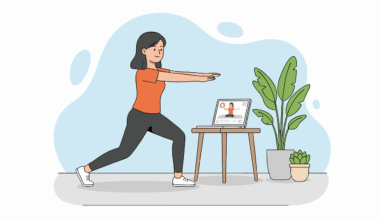Pre-Workout Stretching Tips for Bodyweight Enthusiasts
Bodyweight exercises are a fantastic way to increase strength and flexibility without equipment. However, prior to engaging in these workouts, it’s crucial to perform effective stretching routines to prevent injury and optimize performance. The right stretches help warm up the muscles, promote blood flow, and prepare the body for intense activity. Techniques such as dynamic stretching can be particularly beneficial, as they mimic the movements involved in your exercises. Implementing these techniques will not only enhance your workout but also improve overall flexibility. Consider the following stretches to incorporate into your warm-up routine: arm circles, leg swings, and torso twists. Each of these movements targets multiple muscle groups and gets the body ready for vigorous physical activity. Remember to perform these stretches gently to gradually increase your range of motion and avoid overstretching that can lead to injury. Always listen to your body and adjust the stretches according to your comfort levels. Over time, you’ll notice increased flexibility and enhanced performance when you prioritize stretching before your workouts. This preparation sets the foundation for a successful and injury-free exercise session.
Among the various techniques for stretching, dynamic stretches stand out as particularly effective for bodyweight enthusiasts. These stretches involve moving through a range of motion, unlike static stretches, which are held in a position. Examples of dynamic stretches include high knees, lateral lunges, and walkouts. This activity warms the muscles better and improves your balance, coordination, and flexibility. Implementing a minimum of five to ten minutes of dynamic stretching is ideal before diving into your workouts. Additionally, pairing this with mobility drills can further enhance joint function. As you warm up before your workout, pay attention to any stiffness or discomfort and adjust accordingly. Listen to your body carefully throughout this process. After a session of dynamic stretching, take a moment to observe how your body feels. By incorporating various movements and emphasizing controlled, fluid actions, you set a solid foundation for your subsequent training. This attention to warming up creates a channel for effectively engaging in bodyweight exercises like squats, push-ups, or planks. Prioritizing these stretches boosts results while reducing the overall risk of injuries.
Balancing your pre-workout routine with both dynamic and static stretches can lead to even better results for bodyweight workouts. Static stretches involve holding a position for a set period, which helps to maintain flexibility after your muscles are warmed up. These stretches should be performed cautiously, as overextending can cause muscle strain. Choose static stretches for muscles that you know you will heavily utilize during your sessions. Common static stretches for bodyweight exercise enthusiasts might include quadriceps stretches, seated forward bends, or butterfly stretches. Hold each stretch for at least twenty to thirty seconds to experience positive benefits and improved flexibility. It is vital to perform these post-exercise to help in muscle recovery and prevent stiffness. However, remember to avoid doing deep static stretches immediately before a workout, as they can temporarily reduce strength and power. Timing is essential. Carefully integrate these into your regular routine to strike the perfect balance between flexibility and strength. Through diligence and attention, you will find a pre-workout stretching routine that enhances your overall performance and enjoyment of bodyweight exercises significantly.
Importance of Flexibility for Injury Prevention
Flexibility plays an essential role in optimizing performance during bodyweight exercises. When you maintain adequate flexibility, your muscles can effectively produce the necessary strength and power for movements such as dips, squats, and more. Furthermore, improved flexibility aids in injury prevention, ensuring that you can withstand the physical demands of your workout. Muscles and tendons that are not flexible are at an increased risk of injury when subjected to sudden movements. Therefore, incorporating an effective stretching routine, both before and after your workout, is crucial. Pay attention to specific muscle groups regularly used in your routines, such as hip flexors, hamstrings, and shoulders. Building flexibility in these areas results in a better range of motion, allowing for optimal strength application during your exercises. As a result, you’ll experience improved performance and a reduced chance of injury when performing bodyweight exercises. To develop this flexibility, set realistic goals to stretch consistently and gradually increase your ranges. Embrace a mindset connecting stretching with long-term fitness benefits, creating a more rewarding training routine for your bodyweight workout regimen.
Engaging in stretching not only prevents injuries but also enhances muscle recovery post-exercise. After completing intense bodyweight workouts, your muscles go through a recovery phase, where proper stretches can alleviate tension and promote better circulation. This leads to a more efficient recovery process and minimizes soreness. Incorporate stretches like the child’s pose and downward dog after workouts to help your muscles relax. Especially after strenuous sessions, providing your muscles with a chance to cool down through gentle stretching can prevent post-workout stiffness or discomfort. A cool-down routine should also last at least five to ten minutes, allowing your body to transition effectively from high-intensity activity to a resting state. It’s the perfect time to focus on your breathing and control your movements at a slower pace. Consistently committing to stretching after workouts fosters a positively reinforcing cycle of enhanced flexibility and stronger body awareness during your next workout. Mastering your post-workout routine is imperative, allowing your body to rebuild and prepare for future bodyweight challenges. Over time, this habit will significantly improve your workout efficiency and satisfaction.
Listening to Your Body
A key aspect of any successful stretching routine is tuning into your body’s signals. Observe how your muscles respond during both dynamic and static stretches. If you feel any discomfort beyond a mild pull, it’s vital to ease off and avoid pushing into pain. Each individual’s body has unique limitations, so customize your approach to stretching accordingly. Allocate time for self-assessment and reflection regarding your flexibility. Occasionally, you might discover specific stretches that work better for you than others, depending on your unique muscle structure. Incorporate adjustments based on these findings, guiding you toward an effective stretching practice. Moreover, consider collaborating with a fitness trainer or attending classes that specialize in flexibility exercises. They can provide valuable insights tailored to your personal workouts, ensuring you’re not only stretching effectively but also targeting the right muscle groups. Making adjustments based on your body’s feedback will significantly enhance your results. Build this practice over time to cultivate a stronger understanding of your body and its needs, which leads to more enjoyable and productive workouts. This ongoing awareness fosters long-term commitment to fitness goals.
In conclusion, pre-workout stretching is essential for bodyweight exercise enthusiasts. Adequate and well-planned warm-ups prepare your body for physical activity and foster a climate for achieving your fitness goals successfully. Use a mix of dynamic and static stretches to enhance flexibility before and after workouts. Incorporate a balance that emphasizes muscle recovery while maintaining injury prevention. Listening to your body is a crucial technique in developing your stretching routine. Pay attention to how your muscles adapt and respond to different stretches, customizing your approach according to your specific needs. This not only sets the stage for effective workouts but also nurtures a lifelong commitment to fitness. Finally, continuously refine your stretching routine based on practice, experiences, and research findings, developing smarter training habits over time. In doing so, you will not only enhance your bodyweight workout performances but also cultivate a healthier lifestyle overall. Therefore, prioritize stretching as an integral part of your fitness plan, contributing to well-being and long-term sustainability within your bodyweight journey.
Embracing the full benefits of stretching techniques and applying them rigorously will make a noticeable difference in your bodyweight workout experience. Empower yourself by committing to a stretching routine that works effectively for your body and aligns with your fitness aspirations. Or, seek support if needed when figuring this out. Explore various options, embrace new trends, and keep your routine fresh while remaining focused on functionality and effectiveness. You will undoubtedly find the reward of improved performance, increased flexibility, and reduced injury risk incredibly beneficial now and in future workouts. This dedicated approach to stretching will enhance your enthusiasm and results in any fitness endeavor.


